Roof Pavers for Elevated Rooftop Decks
Roof pavers of either porcelain or Ipe wood supported by adjustable height deck supports, vastly expand options for building rooftop decks as well as significantly simplifying site preparation, delivery of materials and construction. The wide diameter, flat base roof paver supports avoid damage or penetration of existing waterproof membranes, eliminate the need for wood or steel structures, enable pipework, ductwork and cabling to be hidden from view, yet still permit easy access for inspection and maintenance.
For locations with strict fire codes, not only do porcelain roof deck pavers offer a totally fireproof surface for roof decks, but we now offer a range of totally non-combustible steel paver supports – providing continuous height adjustment from as low as 1″ up to a max. of 20″.
Adjustable deck supports can be used to support all types of structural rooftop pavers – porcelain pavers and planks, structural wood tiles, concrete pavers, wood and composite wood planks – for a simple to build, perfectly level, rooftop deck flooring solution.
Alternatively, for a quick and easy solution that will cover a rooftop with a solid wood floor, particularly in smaller spaces on residential structures, our interlocking Ipe wood deck tiles can be a great option.
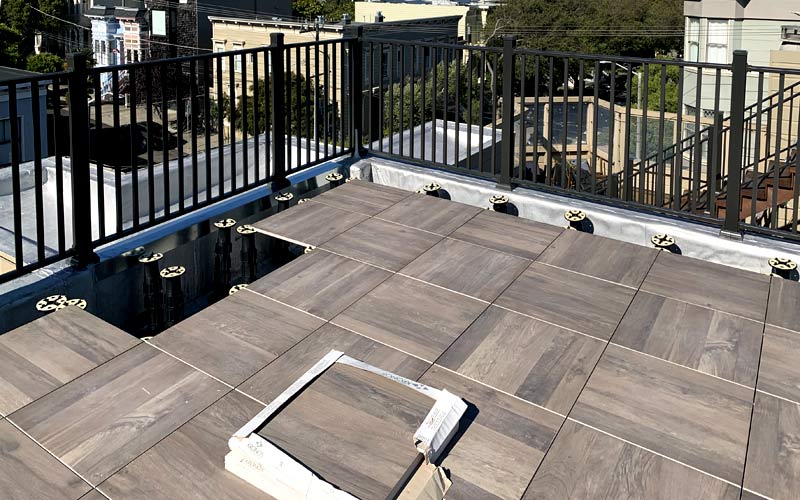
Porcelain Pavers
Offering an exceptionally wide range of color and style options to harmonize with any rooftop environment, porcelain pavers are also totally fireproof, stain resistant, fade resistant, mold and mildew resistant and low maintenance.
These lightweight roof pavers are typically supported only under each corner using pedestal supports, subject to paver size and application. At the lowest elevations, stackable rubber support pads are typically used up to an elevation of approx. 1 ½”.
In certain locations, wind uplift mitigation and break through protection may need to be implemented for roof deck systems, depending on deck height, application and location. Archatrak offers several solutions for both wind uplift and break through protection for roof deck applications. We also offer a snow melt system that can be installed under just a few roof pavers or an entire rooftop deck, on either new installations or retrofitted to existing elevated roof decks.
See more information on porcelain roof deck pavers here.
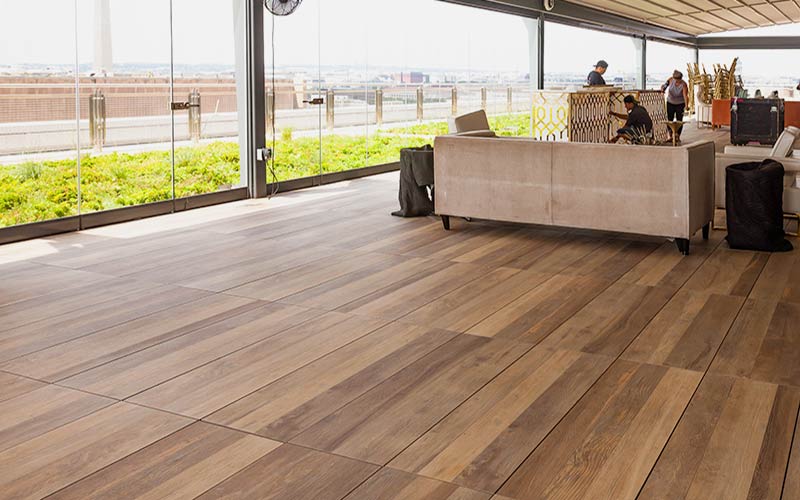
Porcelain Planks
Resembling natural wood planks, porcelain planks offer a totally fireproof solution for rooftop decks, an increasingly important consideration in high density urban locations. Porcelain is also highly resistant to staining, fading, color change, growth of mold, moss and mildew. Plus there’s no twisting, warping, cracking, decay or splintering – a porcelain deck will look essentially the same year after year.
Porcelain planks are typically 8”, 12” or 16″ wide and up to 94″ long. Most planks feature a simulated wood look but some planks are also available in other styles including cement and stone.
Planks are typically installed on roof decks and balconies over an array of hollow steel beams mounted on pedestals, laid either in running bond or stack bond configuration.
Wind uplift mitigation and break through protection may need to be implemented, depending on deck height, application and location.
See more information on porcelain planks here.
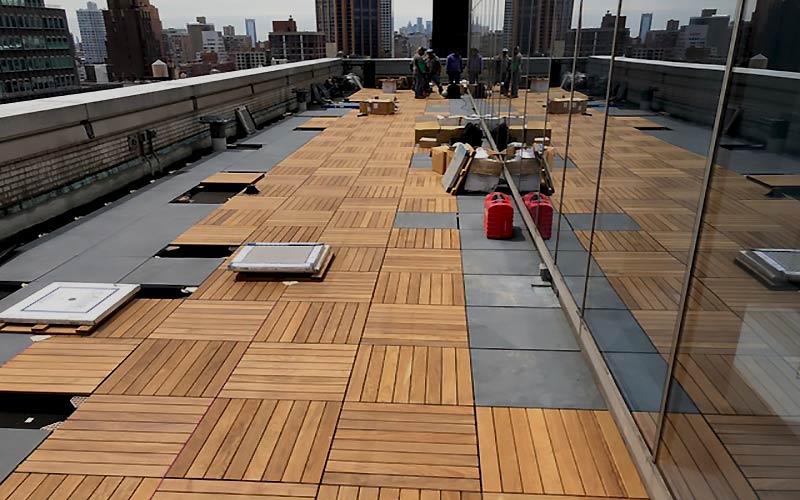
Structural Wood Decking Tiles
The ideal option for a classic wood look roof deck but avoiding the need for extensive support structures.
24” x 24” wood decking tiles are typically supported under each corner only with adjustable height pedestals. 24” x 48” wood tiles are also available.
Fire codes may restrict usage in some localities and long-term maintenance requirements need to be taken into account.
Archatrak structural wood tiles are available exclusively in Ipe wood.
In some locations, wind uplift may need to be considered. Archatrak supplies a screw and washer hold down assembly which secures the corners of each paver to the pedestal head, offering a degree of wind uplift mitigation. Additional mitigation could be achieved by gluing the pedestal base to the substrate.
See more information on structural wood tiles here.
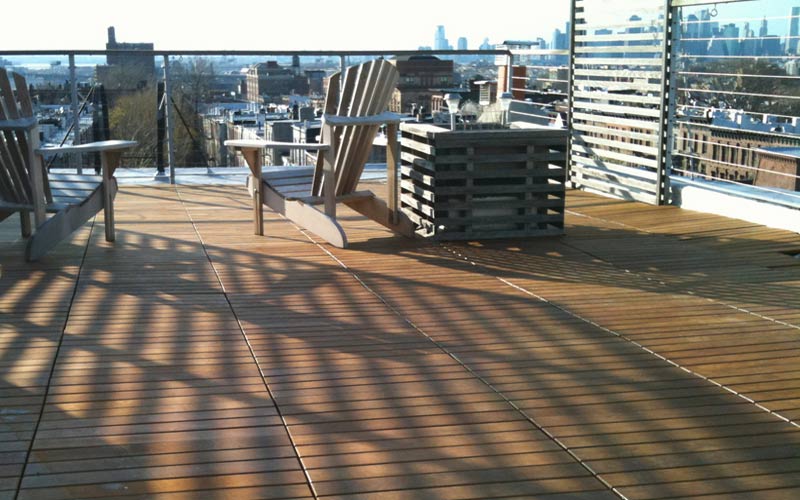
Interlocking Ipe Wood Deck Tiles
Typically laid directly over roof membranes on smaller areas as a Do-It-Yourself option, these 12” x 12” or 12“x 24” modular tiles offer a quick and easy rooftop deck flooring solution by simply snapping together, each tile automatically aligned and precisely spaced, thanks to the connecting tabs on the integral plastic base.
Be aware however that the finished deck will slope in the same direction as the existing rooftop since these tiles are not designed to be supported by pedestal support systems. Hence they cannot be used to cover pipework, ducts and cabling.
Fire codes may restrict their usage in some localities although Ipe is generally classified as a Class A material by the NFPA.
Ipe tiles will gradually fade to a silvery grey over time even if our recommended regime of regular decking oil application is maintained.
See more information on interlocking deck tiles here.
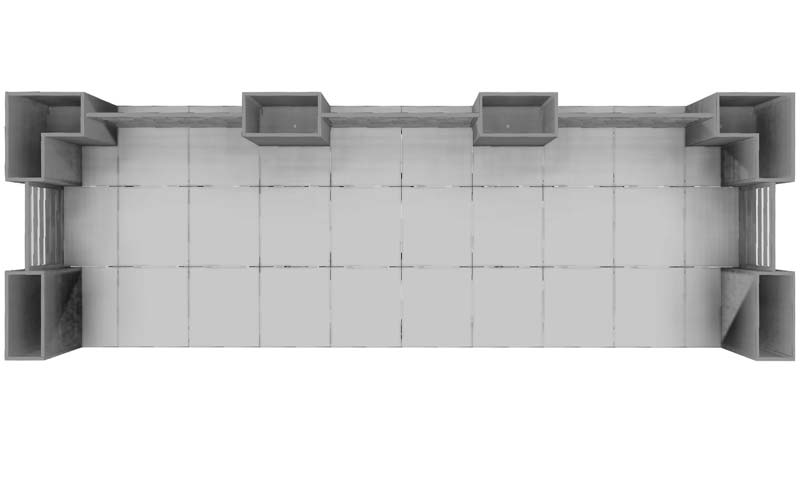
Platforms & Outdoor Stages
For some commercial applications in particular, there may be a need for a raised platform on some section of the deck for use as a stage or a display platform. While this can be achieved by constructing a platform with pedestal supported pavers and using our vertical face clips to create vertical face at the outside edge of the elevated platform, a much neater solution can be to use our StreetDeck modular deck system.
This system also uses pedestal supported porcelain (or Ipe wood) pavers to match the rooftop pavers on the main elevated deck, but offers the benefit of a secure steel containment which prevents any sideways movement of the pavers.
The platform can be extended without limit in increments of 24″ in both length and width. Fully integrated planters and railings can be supplied as required.
See more information on StreetDeck modular decks and platforms as well as applications for street side community Parklets here.